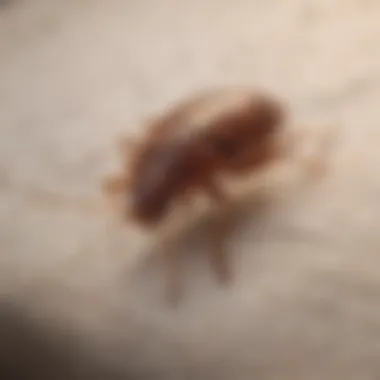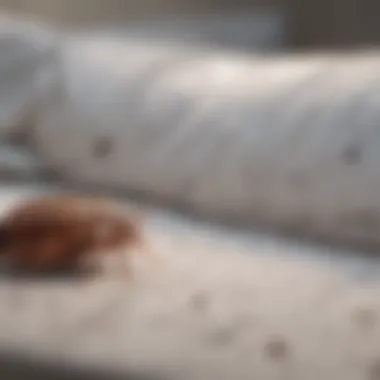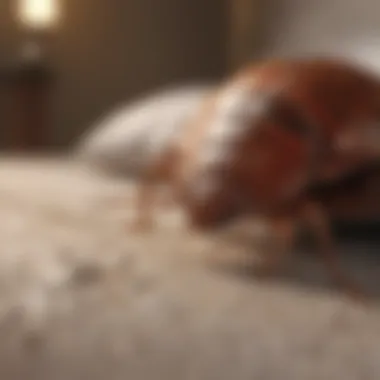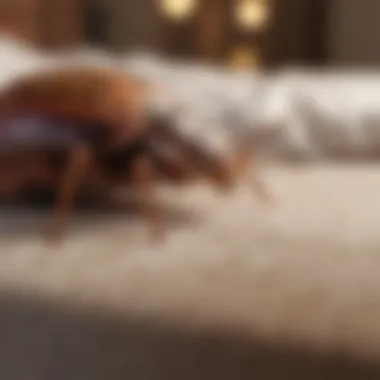Effective Strategies for Eliminating Bed Bugs


Intro
Dealing with bed bugs poses a significant challenge for many homeowners, property managers, and travelers alike. These small, elusive insects can disrupt daily living in profound ways, leading to sleepless nights and increased stress. Understanding the biology and behavior of bed bugs is essential for effective eradication. A strategic approach to managing and eliminating these pests can turn the tide in favor of those affected. This article delves into various methods for spotting, eradicating, and preventing bed bug infestations at home, aiming to empower readers with the necessary tools and knowledge.
Identifying Infestation Areas
Timely detection is crucial in the battle against bed bugs. Begin by examining common hiding spots where bed bugs prefer to dwell. These areas often include:
- Mattresses and box springs
- Bed frames and headboards
- Upholstered furniture
- Cracks and crevices in walls
- Carpets and rugs
- Behind electrical outlets
Signs of infestation can include small, reddish-brown stains on sheets and mattress seams, as well as the presence of small, dark spots of bed bug excrement.
Chemical Eradication Strategies
When the presence of bed bugs is confirmed, chemical treatments can be highly effective. It is advisable to look for insecticides specifically formulated for bed bug control. These products typically contain pyrethroids or neonicotinoids. Follow the instructions carefully and ensure the product is safe for indoor use. Apply chemicals in a targeted manner, concentrating on identified hotspots without over-saturating the area.
Important safety precautions include:
- Using protective gear while applying chemicals
- Keeping children and pets away from treated areas
- Scheduling treatments during off-hours to minimize exposure
Non-Chemical Eradication Methods
In addition to chemical treatments, there are also non-chemical strategies that can be employed. These methods can be particularly helpful for those who prefer a more environmentally friendly approach.
Non-chemical strategies include:
- Heat treatment: Exposing infested items to high temperatures can kill bed bugs effectively. An increase to 120°F (49°C) for an extended time can eliminate them.
- Vacuuming: Regular vacuuming of infested areas can help reduce the population significantly. When finished, seal the vacuum bag tightly and dispose of it immediately.
- Diatomaceous earth: This natural powder can be sprinkled in infested areas. It works by damaging the protective coating of bed bugs, leading to dehydration.
Prevention Methods
Once bed bugs have been eradicated, maintaining a preventive strategy is crucial to avoid future infestations. Here are some effective measures:
- Regular inspections: Frequently check bedding, furniture, and luggage for signs of bed bugs, especially after traveling.
- Reduce clutter: Keeping living spaces free from unnecessary items makes it harder for bed bugs to hide.
- Use protective covers: Encase mattresses and box springs in bed bug-proof covers to prevent future infestations.
By systematically applying these strategies, homeowners can reclaim their homes from bed bugs. This comprehensive understanding of both the behavior of bed bugs and the methods available for eradication equips readers to tackle the issue effectively and regain peace of mind.
Understanding Bed Bugs
Understanding bed bugs is essential for anyone looking to manage or eliminate an infestation at home. Bed bugs, scientifically known as Cimex lectularius, are small, elusive insects that feed on human blood. Their presence can lead not only to physical discomfort but also to psychological stress and social stigma. To effectively deal with these pests, one must first grasp their biology, habits, and the signs that indicate an infestation. This knowledge is crucial for homeowners, interior design enthusiasts, party hosts, and gardening aficionados who aim to maintain a safe and comfortable living environment.
Biology of Bed Bugs
Bed bugs are small, approximately 5 to 7 mm in length, and have flattened, oval bodies that allow them to hide in tiny crevices. They have an outer shell that is reddish-brown in color, which can become more noticeable after feeding as it swells from the meal. Bed bugs are primarily nocturnal, which means they are most active during the night. They possess specialized mouthparts that allow them to pierce the skin of their hosts and withdraw blood, their primary food source.
Their biology also plays a significant role in their resilience. Bed bugs are capable of surviving long periods without feeding – sometimes up to a year. This makes eradication efforts more challenging and requires a comprehensive approach. Their ability to reproduce quickly, with females laying up to five eggs a day, accelerates the spread of infestations, making early detection and intervention vital.
Life Cycle and Habits
Bed bugs undergo a simple life cycle consisting of three life stages: eggs, nymphs, and adults. The cycle begins when a female bed bug lays eggs in hidden places. These eggs are tiny, about 1 mm in length, and can be easily overlooked. After several days, the eggs hatch into nymphs. Nymphs are smaller than adults and must feed on blood to molt into their next stage. This molting process occurs five times before reaching adulthood, taking about five weeks.
Bed bugs prefer environments that are dark, warm, and near their human hosts, typically hiding in mattresses, furniture, and cracks in walls. Their habits contribute to their persistence in homes. They tend to remain close to their food source, emerging only to feed.


Signs of Infestation
Identifying the signs of a bed bug infestation early can save homeowners from distress and extensive treatment. Here are the most common indicators:
- Bites: Red, itchy welts on the skin, often in a line or cluster, may signal bed bug bites.
- Exoskeletons: Shed skins resembling small, dried versions of adult bed bugs can be found in hiding spots.
- Fecal Stains: Dark spots or streaks on bedding and walls can indicate a bed bug presence due to their droppings.
- Eggs: Tiny, white eggs about 1 mm in size can be found in areas where bed bugs hide.
Being proactive in inspecting these signs can lead to timely action that prevents serious infestations.
Identifying Infested Areas
Identifying infested areas is a crucial step in managing a bed bug problem effectively. Accurate identification can save time and resources. Knowing where to look helps you target your efforts to eradicate these pests. Bed bugs are skilled at hiding, making it essential to conduct a thorough inspection. Failing to locate these hidden areas may lead to missed bugs and a prolonged infestation.
Several elements come into play when determining if an area is infested. Firstly, understanding common hiding spots assists in streamlining inspections. Secondly, employing effective inspection techniques enhances the probability of discovering pest locations early. Additionally, noting the behavior of bed bugs can guide your search effectively.
Common Hiding Spots
Bed bugs tend to be elusive, retreating to various hiding places during the day. Their favored locations can include:
- Mattresses and box springs: Inspect seams, edges, and even the tags. These spots are highly prone to infestations because bed bugs thrive in places close to their hosts.
- Furniture: Couches, chairs, and dressers can harbor bed bugs in small crevices and upholstery.
- Cracks and crevices: Baseboards, wall sockets, and structural cracks are inviting environments for bed bugs to hide.
- Luggage and personal belongings: If you travel frequently, be cautious of bringing bed bugs home from hotels or other locations.
- Clothing and linens: Dresser drawers and laundry baskets represent easy targets for these pests.
Noticing signs of bed bugs—such as fecal spots, shed skins, and bite marks—can also indicate where to focus your searches.
Inspection Techniques
Effective inspection techniques can enhance your chances of identifying infested areas. Here are some recommended methods to follow:
- Visual Inspection: Conduct a systematic search with a flashlight, checking the aforementioned hiding spots while paying close attention to details.
- Turn over furniture and linens: Displacing items allows you to inspect underneath and behind them.
- Use tools: A stiff brush can help dislodge bed bugs from their hiding places, while duct tape can be used to capture adult bed bugs and nymphs for identification.
- Heat detection technology: Some companies utilize infrared technology to locate heat produced by bed bugs, aiding in pinpointing their locations.
- Monitor traps: Consider placing bed bug detection devices or traps in likely areas to capture pests early on and confirm their presence.
"Finding bed bugs early prevents a larger infestation and makes eradication much simpler."
By employing these strategies, homeowners can better identify infested areas and take prompt action towards treatment. In the next sections, we will explore various methods of eradicating these pests, ensuring a comprehensive understanding to safeguard your living spaces.
DIY Bed Bug Eradication
DIY bed bug eradication is crucial for homeowners facing infestations. Taking action yourself can save time and money. It can also provide immediate results. Understanding specific strategies is essential. Some people may prefer DIY methods over calling professional services. However, it requires dedication and proper techniques. Whether to control an early stage of infestation or maintain a pest-free zone, knowing effective DIY strategies plays an important role.
Cleaning and Decluttering
Cleaning and decluttering are fundamental steps in any bed bug eradication effort. Reducing clutter immediately minimizes hiding spots. Bed bugs thrive in mess, so an organized home can drastically decrease their food supply. Start by removing items you no longer need. Wash all bedding, linens, and clothing in hot water. Heat above 120°F (49°C) kills bed bugs in all life stages. Consider using a dryer on high heat for at least 30 minutes after washing. Regular cleaning routines can also make it easier to spot signs of infestation earlier.
Heat Treatment
Heat treatment is one of the most effective methods to eliminate bed bugs. This approach involves raising the temperature of an entire room or specific items to a level that is lethal to these pests. Bed bugs cannot survive temperatures above 120°F (49°C). You can use specialized heating equipment or portable heaters for this purpose. Apply heat consistently for several hours to ensure comprehensive coverage. Remember to monitor the area closely to prevent any potential damage to household items.
Freezing Methods
Freezing is another viable option for eradicating bed bugs. When exposed to temperatures below 0°F (-18°C), bed bugs generally perish within four days. This method works well for smaller items. Seal infested items in plastic bags and place them in the freezer. Ensure that the temperature remains low for the required duration. It is essential to check the effectiveness of this method, as large, thick items may need longer exposure time to the cold to be effective.
Vacuuming and Steam Cleaning
Vacuuming is a quick and effective way to reduce the number of bed bugs. Use a vacuum with strong suction to pick up visible bugs and eggs from surfaces like floors and furniture. Pay close attention to seams and crevices. After vacuuming, dispose of the bag or empty the canister outside to prevent reinfestation. In addition, the use of steam cleaners offers a dual benefit. They disinfect while killing bugs. When steam cleaning, ensure the steam is consistently over 130°F (54°C) for effective results.


Chemical Treatments: An Overview
Chemical treatments can complement other DIY strategies. Insecticides labeled for bed bugs come in various formulations. This includes sprays, powders, and aerosols. Always read and follow label instructions. Some products target specific lifecycle stages of bed bugs. For serious infestations, it may be necessary to use multiple products. Be cautious of resistant strains. Chemicals work best when combined with integrated pest management strategies.
Natural Remedies
For those seeking alternatives, natural remedies may also aid in bed bug eradication. Essential oils like tea tree, lavender, and peppermint have shown potential repellent properties. However, they may not be entirely effective on their own. Using natural options can be more time-consuming and might not provide immediate relief.
Key Point: Always speak with a pest control professional before implementing natural remedies to ensure they fit within your overall eradication plan.
Ultimately, DIY bed bug eradication requires a multifaceted approach. Combining cleaning, heat, vacuuming, and appropriate chemical treatments offers the best chance of fully removing these unwelcome invaders.
Professional Pest Control Options
When battling bed bugs, many homeowners may reach a point where DIY efforts seem ineffective. This is when professional pest control options become crucial. Relying on expert services can bring a wealth of benefits, including specialized knowledge, advanced techniques, and comprehensive plans tailored to the specific situation at hand. Professionals are equipped with tools and methods that are not available to the average person, enhancing the effectiveness of eradication efforts. Understanding when to bring in professionals is an important part of the overall strategy to eliminate these pests.
When to Call an Exterminator
Recognizing the right moment to contact an exterminator is essential for successful bed bug eradication. If the infestation is severe or increasing despite being treated through DIY methods, it is time to seek professional help. Indicators for calling an exterminator include:
- Multiple sightings of bed bugs over a short period.
- Visible signs of bites on yourself or family members.
- An increase in bug activity in areas adjacent to the original sighting.
- Difficulty in identifying all infested areas, especially if you are unsure where to look.
- A feeling of frustration or stress due to the infestation.
It is wise to act quickly, as bed bugs reproduce rapidly. Delaying treatment can lead to a more extensive and entrenched infestation.
Choosing the Right Pest Control Service
Selecting a pest control service is a decision that should not be taken lightly. A reputable service not only addresses the immediate problem but also offers peace of mind in terms of safety and effectiveness. Here are key factors to consider:
- Certification and Insurance: Ensure the company is licensed and insured. Check qualifications and affiliations with relevant professional organizations, such as the National Pest Management Association.
- Experience with Bed Bugs: Look for a service that specializes in bed bug treatments and has a proven track record.
- Treatment Methods: Inquire about the methods they employ. Effective techniques might include heat treatments, chemical applications, or more innovative approaches.
- Reviews and References: Seek testimonials from previous customers. Online platforms like Reddit or Angie's List can provide valuable insights.
- Written Estimates: Obtain detailed estimates in writing that breaks down costs. Transparency in pricing can help avoid additional fees in the future.
What to Expect from Professional Services
Engaging a pest control service involves understanding what to anticipate from the process. Although individual experiences may vary, most services will follow a general outline:
- Initial Inspection: The process typically begins with a thorough inspection of the premises to assess the severity and scope of the infestation.
- Customized Treatment Plan: Professionals will offer a tailored treatment plan based on their findings. This plan may involve multiple approaches for maximum effectiveness.
- Execution of Treatment: The treatment will be carried out as discussed, using the appropriate methods. Homeowners may be required to prepare areas beforehand.
- Follow-Up Visits: Many reputable services will schedule follow-up inspections and treatments to ensure continued success. These visits might include recommendations for preventing future infestations.
Each step aims to eradicate existing bed bugs while providing strategies to avoid re-infestation. Professional pest control services not only manage the current problem but also lay the groundwork for a more secure living environment.
Preventing Future Infestations
Preventing future infestations of bed bugs is critical for maintaining a bed bug-free environment within the home. Addressing this issue ensures that the efforts taken to eliminate these pests do not go to waste. Once bed bugs are eradicated, a homeowner must implement several strategies to reduce the likelihood of their return. A proactive approach not only safeguards the living space but also contributes to overall health and comfort.
Sealing Entry Points
One effective method of preventing re-infestation is sealing potential entry points. Bed bugs are excellent hitchhikers. They can easily enter a home through various openings. To combat this, inspect areas around windows, doors, and any cracks in walls. Use caulk to seal gaps and weather stripping to secure doors and windows tightly.
"Small openings could lead to big problems. Ensure every crack is addressed effectively."
Additionally, pay special attention to utility lines and pipes. These often provide a pathway for bed bugs to move between apartments or homes, especially in multi-unit dwellings. Every detail counts when sealing entry points.
Regular Inspections


Conducting regular inspections is another vital practice in preventing bed bug invasions. Setting a schedule for examining common hiding spots allows homeowners to identify potential issues before they escalate into infestations. Check places like your mattress seams, behind picture frames, and under furniture periodically.
- Inspect bedding: Examine sheets and pillowcases closely for small blood spots or shed skins.
- Look in furniture: Check sofas, chairs, and bookshelves, as bed bugs can hide in fabrics and crevices.
- Utilize tools: A flashlight can help uncover hidden bugs, as their small size makes them hard to spot.
If any signs of a bed bug are found, take immediate action to minimize their spread.
Travel Precautions
Travel often introduces new risks for bed bug infestations. Being aware of this is essential, especially for frequent travelers. Before checking into a hotel, research its cleanliness and reputation for pest management. During your stay, keep luggage elevated on stands rather than placing it on the floor or bed.
Upon returning home, consider unpacking clothes immediately and washing them in hot water. Inspect luggage for any signs of bed bugs too. Place suitcases in a garage or on hard surfaces instead of directly indoors until you can check for pests. Taking these precautions significantly reduces the chances of bringing unwanted guests back into your home.
Implementing these strategies creates a comprehensive defense against bed bugs. It is necessary to remain vigilant and consistent in these practices. By adopting these habits, homeowners can maintain a secure and pest-free living space.
Long-Term Management Strategies
Effectively managing bed bugs requires a sustained approach beyond initial eradication. Long-term management strategies are essential for preventing future infestations and ensuring a healthy living environment. The focus should be on routine maintenance and the proactive steps one can take to keep these pests at bay.
Regular Maintenance
Regular maintenance plays a critical role in long-term bed bug management. This refers to ongoing practices that help maintain a clean and pest-resistant home. It is important to incorporate the following practices into your routine:
- Frequent Cleaning: Vacuum all rooms at least once a week, paying special attention to carpets, rugs, and upholstery. Empty the vacuum bag or canister immediately after each use to eliminate any potential bed bugs or eggs.
- Washing Bedding and Linens: Wash all bedding, linens, and curtains in hot water regularly. Drying on high heat assists in killing any bugs or eggs that may be present.
- Decluttering: Reducing clutter provides fewer hiding spots for bed bugs. Regularly assess your belongings and dispose of or donate items you no longer need.
- Inspection of Furniture and Electronics: Regularly inspect furniture and electronic devices for signs of bed bugs. Pay attention to seams, cracks, and crevices where bugs might reside.
Routine check-ups and cleaning can significantly reduce the risk of regaining an infestation.
Utilizing Monitoring Devices
Monitoring devices complement preventative measures by offering a way to catch bed bugs before they become a larger problem. These devices are useful for providing insight into potential infestations.
- Bed Bug Detection Systems: These systems can include traps specifically designed to capture bed bugs. Placing traps at strategic locations, such as near beds and furniture, can help detect early signs of infestation.
- Monitoring Monitors: These are devices that attract bed bugs through heat and carbon dioxide, similar to how humans are attracted. They can be placed in high-risk areas and monitored regularly.
"Using monitoring devices can help identify bed bugs before they become a major problem, allowing homeowners to take immediate action."
Utilizing monitoring devices not only helps to confirm the presence of bed bugs, but also provides peace of mind. They serve as a critical proactive strategy in long-term management. Implementing both regular maintenance and monitoring will create a strong defense against bed bugs, fostering a more comfortable living environment.
End
The conclusion of this article is fundamental in synthesizing the efforts taken to understand and combat bed bug infestations. It is crucial to wrap up the discussion while emphasizing not just the eradication strategies, but also the importance of maintaining vigilance post-eradication. This is not merely an issue of comfort; it is a matter of health and well-being.
The presence of bed bugs can lead to significant psychological distress and physical discomfort due to their bites. Therefore, a thorough understanding of the effective strategies discussed provides a path toward achieving a bed bug-free environment. Homeowners must appreciate that the battle against bed bugs is not a singular event but an ongoing process requiring attention.
Additionally, the value of integrating preventative measures into daily routines cannot be overstated. Regular inspections, efficient cleaning practices, and appropriate treatments create a defensive barrier against possible re-infestations. Keeping abreast with the most recent pest control methods enhances your capability to respond swiftly should an infestation reoccur. In essence, a combination of eradicating methods and preventative strategies fosters long-term peace, allowing individuals and families to feel secure within the sanctity of their home.
Summary of Effective Strategies
Effective strategies for eradicating bed bugs revolve around both immediate action and long-term maintenance. Here are key points to remember:
- Identification: Recognizing signs of bed bugs early is paramount. Look for physical evidence like droppings or shed skins in potential hideouts.
- Cleaning: Thorough cleaning involving vacuuming and washing fabrics at high temperatures disrupts their habitat.
- Heat Treatment: High temperatures can kill bed bugs effectively, making it an ideal solution for infested items.
- Chemical Approaches: If opting for chemicals, it is vital to choose pesticides specifically formulated for bed bugs, ensuring safety and effectiveness.
- Natural Remedies: Options like diatomaceous earth offer non-chemical methods to combat infestations.
- Professional Assistance: In severe cases, hiring a pest control service can provide the expertise required to handle extensive infestations.
By utilizing a blend of these strategies, homeowners can devise a customized plan to eliminate bed bugs comprehensively.
Maintaining a Bed Bug-Free Home
To keep your home free from bed bugs, one must adopt a proactive stance. Here are practices that help ensure a sustained bed bug-free environment:
- Sealing Entry Points: Check for gaps and crevices in walls, floors, and around windows. Sealing these can prevent bed bugs from entering your space.
- Regular Inspections: Performing routine checks, especially after travel, helps detect infestations before they escalate.
- Travel Precautions: When traveling, inspect hotel rooms and keep luggage elevated off the floor to avoid picking up bed bugs.
- Decluttering: Minimizing clutter allows better inspection and cleaning, which reduces potential hideouts for bed bugs.
Incorporating these practices into daily life contributes significantly to preserving a bed bug-free home. With diligence and consistent effort, the presence of these pests can be kept at bay.















